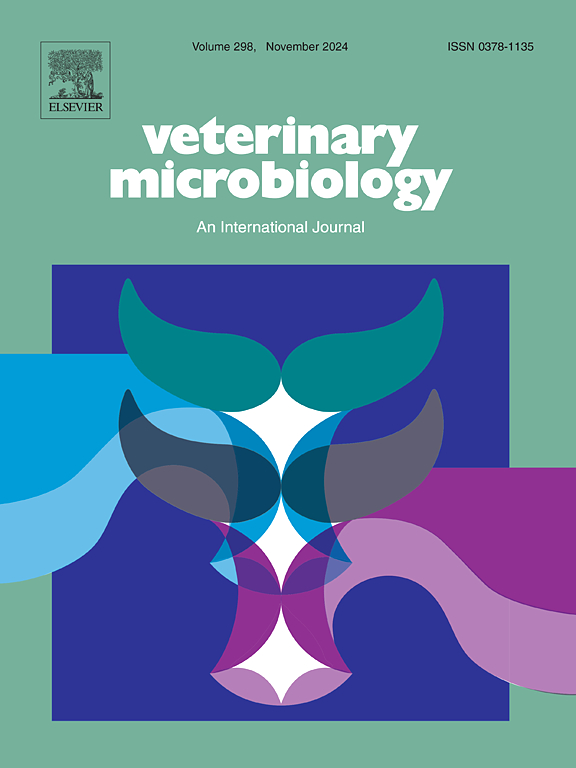Panaxadiol作为HIF-1α抑制剂抑制h9n2诱导的炎症
IF 2.7
2区 农林科学
Q3 MICROBIOLOGY
引用次数: 0
摘要
H9N2禽流感病毒(AIV)对家禽业和公共卫生构成了相当大的威胁,这不仅是因为其广泛流行,而且还因为它有可能通过基因重组促进更强毒性流感毒株的出现。最近的研究强调了缺氧诱导因子1- α (HIF-1α)在病毒发病机制、免疫调节和炎症反应调节中的关键作用,将其定位为抗病毒策略的有希望的靶点。在这项研究中,我们发现HIF-1α积极参与MH-S细胞中H9N2 AIV感染引发的炎症反应。值得注意的是,在感染小鼠模型中,沉默HIF-1α导致发病率和死亡率降低,强调其参与疾病进展。此外,我们探索了Panaxadiol(一种有效的HIF-1α抑制剂)对h9n2诱导的病理的抗炎潜力。在体外,Panaxadiol通过减弱HIF-1α信号,显著减少关键促炎细胞因子的产生,包括IL-1β、IL-6和TNF-α。此外,Panaxadiol通过抑制HIF-1α来减轻cGAS-STING信号的激活。此外,体内给药Panaxadiol可以缓解h9n2感染小鼠的临床症状和肺部炎症,同时增强肺泡上皮再生,这可以通过肺泡II型(ATII)细胞标记物Abca3和sfpb的上调来证明。总的来说,这些发现支持Panaxadiol作为控制流感相关炎症和促进肺修复的有希望的候选者。本文章由计算机程序翻译,如有差异,请以英文原文为准。
Panaxadiol acts as an HIF-1α inhibitor to suppress H9N2-induced inflammation
The H9N2 avian influenza virus (AIV) represents a considerable threat to both poultry industries and public health, not only due to its widespread prevalence but also because of its potential to facilitate the emergence of more virulent influenza strains through genetic reassortment. Recent studies have highlighted the pivotal role of hypoxia-inducible factor 1-alpha (HIF-1α) in viral pathogenesis, immune modulation, and the regulation of inflammatory responses, positioning it as a promising target for antiviral strategies. In this study, we identified that HIF-1α actively contributes to the inflammatory response triggered by H9N2 AIV infection in MH-S cells. Notably, silencing HIF-1α led to reduced morbidity and mortality in infected mouse models, underscoring its involvement in disease progression. Furthermore, we explored the anti-inflammatory potential of Panaxadiol, an potent HIF-1α inhibitor, against H9N2-induced pathology. In vitro, Panaxadiol treatment markedly diminished the production of key pro-inflammatory cytokines, including IL-1β, IL-6, and TNF-α, by attenuating HIF-1α signaling. Moreover, Panaxadiol mitigates the cGAS-STING signaling activation through suppressing HIF-1α. Additionally, in vivo administration of Panaxadiol alleviated clinical symptoms and lung inflammation in H9N2-infected mice, while simultaneously enhancing alveolar epithelial regeneration, as evidenced by the upregulation of alveolar type II (ATII) cell markers, Abca3 and Sftpb. Collectively, these findings support Panaxadiol as a promising candidate for controlling influenza-associated inflammation and promoting lung repair.
求助全文
通过发布文献求助,成功后即可免费获取论文全文。
去求助
来源期刊

Veterinary microbiology
农林科学-兽医学
CiteScore
5.90
自引率
6.10%
发文量
221
审稿时长
52 days
期刊介绍:
Veterinary Microbiology is concerned with microbial (bacterial, fungal, viral) diseases of domesticated vertebrate animals (livestock, companion animals, fur-bearing animals, game, poultry, fish) that supply food, other useful products or companionship. In addition, Microbial diseases of wild animals living in captivity, or as members of the feral fauna will also be considered if the infections are of interest because of their interrelation with humans (zoonoses) and/or domestic animals. Studies of antimicrobial resistance are also included, provided that the results represent a substantial advance in knowledge. Authors are strongly encouraged to read - prior to submission - the Editorials (''Scope or cope'' and ''Scope or cope II'') published previously in the journal. The Editors reserve the right to suggest submission to another journal for those papers which they feel would be more appropriate for consideration by that journal.
Original research papers of high quality and novelty on aspects of control, host response, molecular biology, pathogenesis, prevention, and treatment of microbial diseases of animals are published. Papers dealing primarily with immunology, epidemiology, molecular biology and antiviral or microbial agents will only be considered if they demonstrate a clear impact on a disease. Papers focusing solely on diagnostic techniques (such as another PCR protocol or ELISA) will not be published - focus should be on a microorganism and not on a particular technique. Papers only reporting microbial sequences, transcriptomics data, or proteomics data will not be considered unless the results represent a substantial advance in knowledge.
Drug trial papers will be considered if they have general application or significance. Papers on the identification of microorganisms will also be considered, but detailed taxonomic studies do not fall within the scope of the journal. Case reports will not be published, unless they have general application or contain novel aspects. Papers of geographically limited interest, which repeat what had been established elsewhere will not be considered. The readership of the journal is global.
 求助内容:
求助内容: 应助结果提醒方式:
应助结果提醒方式:


